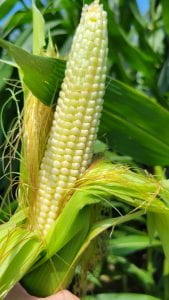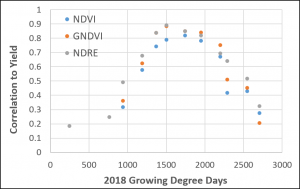Jarrod O. Miller, Assistant Professor and Extension Specialist, Agronomy, jarrod@udel.edu; Amy L. Shober, Professor and Extension Specialist, Nutrient Management and Environmental Quality, ashober@udel.edu, Jamie Taraila, Graduate Research Assistant;
As part of a Northeastern SARE graduate student grant, we used a drone to predict the nitrogen (N) that may be present in cover crops prior to burndown. We flew fields in Laurel, Georgetown, and Harbeson with a readily available consumer drone (Phantom4) equipped with a standard (RGB) camera. Each of the fields were flown prior to cover crop burndown (late April to late May) resulting in 25-100 images per field that had to be stitched together into one image (Figure 1a). The camera captured different wavelengths of light (i.e., red, green, blue) that were reflected by plants which were transformed into the Visible Atmospherically Resistant Index (VARI). This allowed us to estimate plant biomass by comparing VARI values to cover crop biomass that was collected in the field. We collected 10 samples per field, which were dried, weighted, and then analyzed for N content by the UD soil testing lab.



